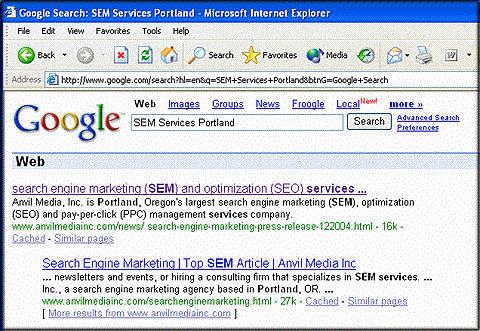This site is for sale,
Learn More
Top Performing Search Engine Content
5 Steps to Top Performing Content
By Kent Lewis, President of
Anvil Media Inc.
Originally Published: March, 2005
As a search engine marketing (SEM) professional, I’ve witnessed the dynamic nature of the SEM industry: rapid growth, a constantly changing landscape and evolving strategies. One thing has not changed in search engine optimization (SEO) since I promoted my first site in 1996: good content performs well in search results.
In 1996, search engine algorithms (Google was still two years from inception) put a heavy weighting on META tags and other source code attributes. Back then, including a specific keyword a handful of times in a META description or keyword tag might earn you a top spot in search results. While META tags no longer have a profound influence on site visibility, good content endures as the most critical aspect of any search algorithm.
Surprisingly, very few companies make the effort to develop a successful content strategy. Below is an outline of 5 steps to developing top performing search engine content. By implementing the recommendations, you can expect to see results within a few months.
Research
If the objective is to create content that performs well in search results, yet also generates leads or sales, the site development team must start by understanding the site visitor. Each stakeholder (prospects, customers, media, analysts, investors and employees) all use a specific vocabulary. By understanding and utilizing specific keyword phrases that resonate with the visitor, a Web site will both rise to the top of the search results and connect with visitors once they’ve clicked through. Utilize various keyword research tools (Overture or WordTracker) to determine keyword popularity and value, then map top performers to relevant content throughout the Web site. See Examples and Resources sections below for more information.
Balance
Once you’ve determined which keywords are most relevant and begin integrating them into site copy, don’t forget to map back to business and communications objectives. Too frequently, marketers tend to use jargon that prospects and customers would never type into a search engine (i.e. “integrated comprehensive solution” instead of “software tool”). On the other hand, SEO experts tend to create content with such a high keyword density as to be unreadable and results in a frustrated visitor departing for a competitor’s site. By maintaining a balance between overall communications and SEM objectives, you will generate the visibility you desire, while generating leads and sales.
Build or Buy
Most companies lack site content that inherently performs well in search engines. As such, new optimized content must be added. For companies with content creation/copywriting capabilities in house, the most difficult challenge is training and management. For companies that have limited in-house resources, hiring SEO copywriting specialists or purchasing syndicated content are options. Evaluating your objectives, internal resources, budgets and timelines will lead you to the optimal choice.
Optimization
While content is still king with search engines (and searchers alike), it doesn’t exist in a vacuum. To ensure the content you’ve so painstakingly incorporated into your site performs well, remember to optimize title, META and ALT tags based on the content of each page before submitting the new pages to search engines (Google, MSN and Yahoo! being the top three engines offering free submission).
Maintenance
Submitting and tracking URLs with a tool like WebPosition is critical in understanding the effectiveness of your content and optimization strategy, yet a “fire and forget” approach to content creation is ultimately a losing battle. While some pages may perform well, they will decrease in rankings over time, as new pages get indexed and the page itself ages and becomes stale. As such, a program of constantly updating existing pages and creating new ones based on analysis of search results is required. Determining whether or not a new page performs generally takes one to two months, as the search engines spider the page and add it to the index before the algorithm can consider it. Since lag times are not known exactly, it is essential that efforts are consistent and diligent.
Promotion
Submitting optimized pages to search engines will get you most of the way there, but not quite all the way. To further leverage the content you’ve created, develop an online PR strategy that includes identifying reciprocal link development and content syndication opportunities. Depending on the perceived value of the content, as well as the target audience, there are a variety of options for generating additional visibility. One strategy is to create press releases that can be submitted to news wires and industry publications. Another is to develop articles that can be submitted to industry publications and portals in exchange for a link back to your site. A more recent strategy is to develop a blog on a free site like Blogger.com. Benefits include building brand awareness and affinity within the blogosphere, driving traffic back to a corporate site via links and improving page rank with Google (since Google owns Blogger.com and tends to value blog content highly due to its relative depth and freshness).
Examples
Content comes in all shapes and sizes. I’ve determined that the below examples consistently score well in search engines with little or no additional optimization efforts required. Just do a search on “SEM Services Portland” in Google and you’ll see how good targeted content can earn top positions.

Kent Lewis is president of
Anvil Media Inc., a search engine marketing agency based in Portland, Oregon.
This article is copyrighted and has been reprinted with permission from FirstPlace Software.
Site Promotion Articles Indexes:
|

![]()
